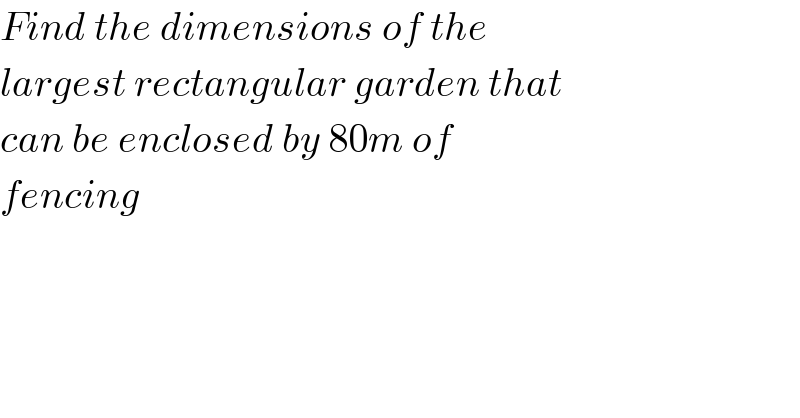Question Number 118570 by rexfordattacudjoe last updated on 18/Oct/20

$${Find}\:{the}\:{dimensions}\:{of}\:{the} \\ $$$${largest}\:{rectangular}\:{garden}\:{that} \\ $$$${can}\:{be}\:{enclosed}\:{by}\:\mathrm{80}{m}\:{of} \\ $$$${fencing} \\ $$
Answered by TANMAY PANACEA last updated on 18/Oct/20

$$\mathrm{2}\left({l}+{b}\right)=\mathrm{80} \\ $$$${l}+{b}=\mathrm{40} \\ $$$${A}={lb} \\ $$$${A}={l}\left(\mathrm{40}−{l}\right)\rightarrow{A}=\mathrm{40}{l}−{l}^{\mathrm{2}} \\ $$$$\frac{{dA}}{{dl}}=\mathrm{40}−\mathrm{2}{l} \\ $$$${for}\:{max}/{min}\:\frac{{dA}}{{dl}}=\mathrm{0}\rightarrow \\ $$$$\mathrm{40}−\mathrm{2}{l}=\mathrm{0}\rightarrow{l}=\mathrm{20} \\ $$$${b}=\mathrm{40}−\mathrm{20}=\mathrm{20} \\ $$$$ \\ $$$$\frac{{d}^{\mathrm{2}} {A}}{{dl}^{\mathrm{2}} }=−\mathrm{2}\:<\mathrm{0} \\ $$$$\boldsymbol{{so}}\:\boldsymbol{{length}}=\mathrm{20} \\ $$$$\boldsymbol{{breath}}=\mathrm{20} \\ $$$$ \\ $$
Commented by JDamian last updated on 18/Oct/20
if you replace 80 with P (perimeter) you'll get P/4; which it means "square"... because the square is the rectangle which gets the biggest area for a given perimeter.
Commented by rexfordattacudjoe last updated on 18/Oct/20

$${thank}\:{you}\:{very}\:{much} \\ $$
Answered by 1549442205PVT last updated on 18/Oct/20

$$\mathrm{Denote}\:\mathrm{by}\:\mathrm{a}\:\mathrm{and}\:\mathrm{b}\:\mathrm{be}\:\:\mathrm{the}\:\mathrm{length}\:\mathrm{and} \\ $$$$\mathrm{width}\:\mathrm{of}\:\mathrm{the}\:\mathrm{garden}\:\mathrm{respectively}.\mathrm{Then} \\ $$$$\mathrm{from}\:\mathrm{the}\:\mathrm{hypothesis}\:\mathrm{we}\:\mathrm{have}: \\ $$$$\mathrm{2}\left(\mathrm{a}+\mathrm{b}\right)=\mathrm{80}\Rightarrow\mathrm{a}+\mathrm{b}=\mathrm{40}\:\mathrm{and}\:\mathrm{the}\:\mathrm{area}\:\mathrm{of} \\ $$$$\mathrm{the}\:\mathrm{garden}\:\mathrm{equal}\:\mathrm{to}\:\:\mathrm{S}=\mathrm{ab}=\mathrm{a}\left(\mathrm{40}−\mathrm{a}\right) \\ $$$$=−\mathrm{a}^{\mathrm{2}} +\mathrm{40a}=−\left(\mathrm{a}−\mathrm{20}\right)^{\mathrm{2}} +\mathrm{400}\leqslant\mathrm{400} \\ $$$$\Rightarrow\mathrm{S}\leqslant\mathrm{400}\:\mathrm{which}\:\mathrm{means}\:\mathrm{S}_{\mathrm{max}} =\mathrm{400}\:\mathrm{m}^{\mathrm{2}} \\ $$$$\mathrm{when}\:\mathrm{a}=\mathrm{b}=\mathrm{20m} \\ $$
